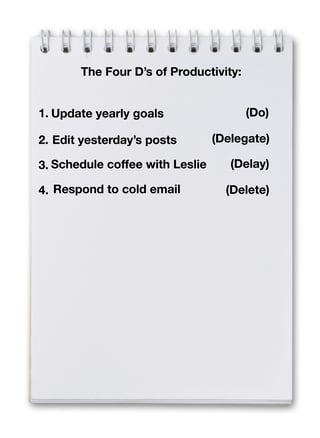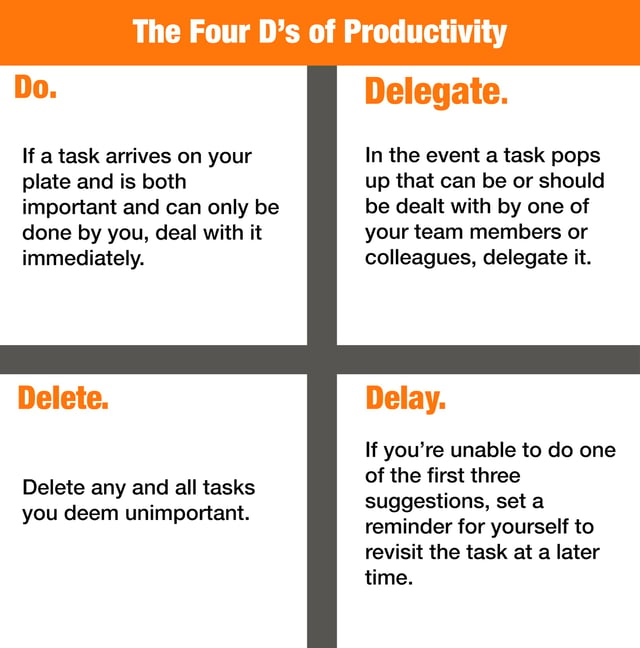According to the OECD Better Life Index, the United States ranks ninth from the bottom among advanced nations in the category of "work-life balance.”

That study is part of the reason we’re seeing more articles published on the topic of productivity. Each aims to answer the burning question we’re all asking: How do we get more done in less time?
And while there are a multitude of strategies to help us reach max productivity, they can be difficult to adopt because the techniques go against the routines we’ve had for years. If you’ve struggled with habit-changing productivity tips like waking up early or regular exercise, you might want to check out the four D's of productivity:
- Do
- Delegate
- Delete
- Delay
The four D’s of productivity are effective because practitioners don’t need to change a habit, but instead embrace a new system. The four D’s work whether you’re an early riser or a night owl. There are no biases to this system -- and you don’t even have to wait 66 days for it to become ingrained as part of your routine.
How the 4 D's of Productivity System Works
1) Do
If a task arrives on your plate and is both important and can only be done by you, deal with it immediately. Accomplishing the task and getting it off your to-do list prevents you from wasting time making a decision about whether you should start or not and frees you up for other projects after it’s done.
It could be something small like an email, or something big like a major project you were recently assigned. But that doesn’t matter. As long as the task fits the two criteria above, it’s up to you to do it.
2) Delegate
In the event a task pops up that can be or should be dealt with by one of your team members or colleagues, delegate it. Not only does this free you up to focus on the more important tasks that lie ahead, the members of your team will stay busy with clear priorities.
3) Delete
Delete any and all tasks you deem unimportant. Instead of adding them to an ever-growing to-do list, deleting these tasks allows you to keep your list manageable and dedicate your time to projects of more importance.
4) Delay
Finally, if you’re unable to do one of the first three suggestions, set a reminder for yourself to revisit the task at a later time. Delaying a non-urgent project removes the pressure to get it done right away, and lets you target your important tasks first.
How to Use the 4 D’s of Productivity
To see what this looks like in practice, let’s say you have four tasks on your to-do list:
- Update annual team goals
- Schedule coffee with Leslie
- Answer a cold email
- Edit a blog post
Which “D” should you apply to each task? Here’s how I would use the 4 D’s system to prioritize these tasks:

- Your company’s executives are in search of updated yearly goals for your team. This is a pressing matter that can only be done by you. This is your do task.
- Delegate editing a post to a writer eager to learn how to edit. This way your blog calendar stays up to date and your team has established priorities.
- Although you want to get coffee with Leslie, scheduling that meeting right now will only cost you time. Delay that until after you’ve completed your "do" task.
- After checking your inbox, you see a cold email from a sales rep you don’t know. Immediately delete this so you don't lose focus and stay on top of email.
Here's a handy visual that can help you prioritize tasks according to the 4 D's of productivity:

Maximum productivity can be difficult to achieve because you often need to develop a new habit -- and habits are difficult to maintain after a few days or weeks. With the four D’s of productivity, you don’t need to develop a new habit, but to instead embrace a system. Get started improving your productivity right away with this simple system.











